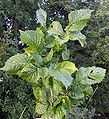Ulmus 'Columella'
| Ulmus hybrid | |
|---|---|
.jpg) 'Columella', Amsterdam.
Photo: Ronnie Nijboer | |
| Hybrid parentage | 'Plantyn', selfed |
| Cultivar | 'Columella' |
| Origin | Wageningen, The Netherlands |
Ulmus 'Columella' is a Dutch elm cultivar raised by the Dorschkamp Research Institute in Wageningen from a selfed or openly-pollinated seedling of the hybrid clone 'Plantyn' sown in 1967. It was released for sale in 1989 after proving extremely resistant to Dutch elm disease following inoculation with unnaturally high doses of the pathogen, Ophiostoma novo-ulmi.[1]
Description
'Columella' makes a tall, fastigiate tree with very upright branches, but broadens in later years . The rough, rounded, and curiously twisted leaves, < 7 cm long, are the result of a recessive gene inherited from its Exeter Elm ancestor, and are arranged in asymmetric clusters on short branchlets. The samarae, broadly obovate, are 13–17 mm long by 10–12 mm wide.
Pests and diseases
Rated 5 out of 5 [2] 'Columella' has a very high resistance to Dutch elm disease.
Cultivation
Wind resistant, the tree has been planted throughout the Netherlands, where its columnar shape has made it popular as a street tree. It is commonly found in Amsterdam, where it has been widely planted as a replacement for the similarly-fastigiate Guernsey Elm, U. minor subsp. sarniensis , itself a replacement for the Belgian Elm, Ulmus × hollandica 'Belgica', which had succumbed so readily to the earlier strain of Dutch elm disease after World War I. 'Columella' has also been planted to replace Guernsey Elm in Edinburgh.[3]
In trials conducted by Butterfly Conservation in southern Hampshire, England, 'Columella' was the only cultivar to become distressed during the drought of 2006, shedding most of its foliage by early August; a trait possibly inherited from one of the tree's ancestors, the Himalayan Elm Ulmus wallichiana. 'Columella' first flowered aged 8 years, in March; the resultant seeds were found to have a moderate viability.[4] 'Columella' featured in New Zealand government trials during the 1990s at the Hortresearch station, Palmerston North, but is not known to have been introduced to North America.
Hybrid cultivars
- Clone FL 666 (Heybroek's 405* × 'Columella'), Istituto per la Protezione delle Piante, Florence. Not in commerce. *(U. × hollandica × U. minor)
- Clone FL 589 ('San Zanobi' × 'Columella'), Istituto per la Protezione delle Piante, Florence. Not in commerce.
Etymology
The hybrid is named for the Roman agronomist Columella, who introduced the Atinian elm (now more commonly known as the English Elm) to Spain from Italy circa AD 50.
Accessions
North America
- United States National Arboretum, Washington D.C., Acc. no. Q28832 (quarantine)
Europe
- Arboretum de La Petite Loiterie , Monthodon, France. No details available.
- Brighton & Hove City Council, UK, NCCPG elm collection . East Drive, Queen's Park.
- Grange Farm Arboretum, Sutton St James, Spalding, Lincs., UK. Acc. no. 818.
- Great Fontley, Fareham, UK, Butterfly Conservation Elm Trials plantation, Home Field I6, (planted 2003).
Nurseries
Europe
- Boomwekerijen 'De Batterijen' , Ochten, Netherlands
- Boomkwekerij 't Herenland , Randwijk, Netherlands
- Hilliers Nurseries , Ampfield, UK. Standards only.
- Noordplant , Glimmen, The Netherlands
- PlantenTuin Esveld , Boskoop, Netherlands
- UmbraFlor , Spello, Italy
- Westerveld Boomkwekerij B.V., Opheusden, Netherlands
References
- ↑ Heybroek, H. (1993). The Dutch Elm Breeding Program. In Sticklen & Sherald (Eds.) (1993). Dutch Elm Disease Research, Chapter 3. Springer Verlag, New York, USA.
- ↑ Heybroek, H. M., Goudzwaard, L, Kaljee, H. (2009). Iep of olm, karakterboom van de Lage Landen (:Elm, a tree with character of the Low Countries). KNNV, Uitgeverij. ISBN 9789050112819
- ↑ Established 'Columella' plantings in Castle Terrace and Glengyle Terrace; recent plantings in Bellevue Place and Bruntsfield Links.
- ↑ Brookes, A. H. (2012). Disease-resistant elm cultivars, Butterfly Conservation trials report, 2nd revision, 2012. Butterfly Conservation, Hants & IoW Branch, England.


